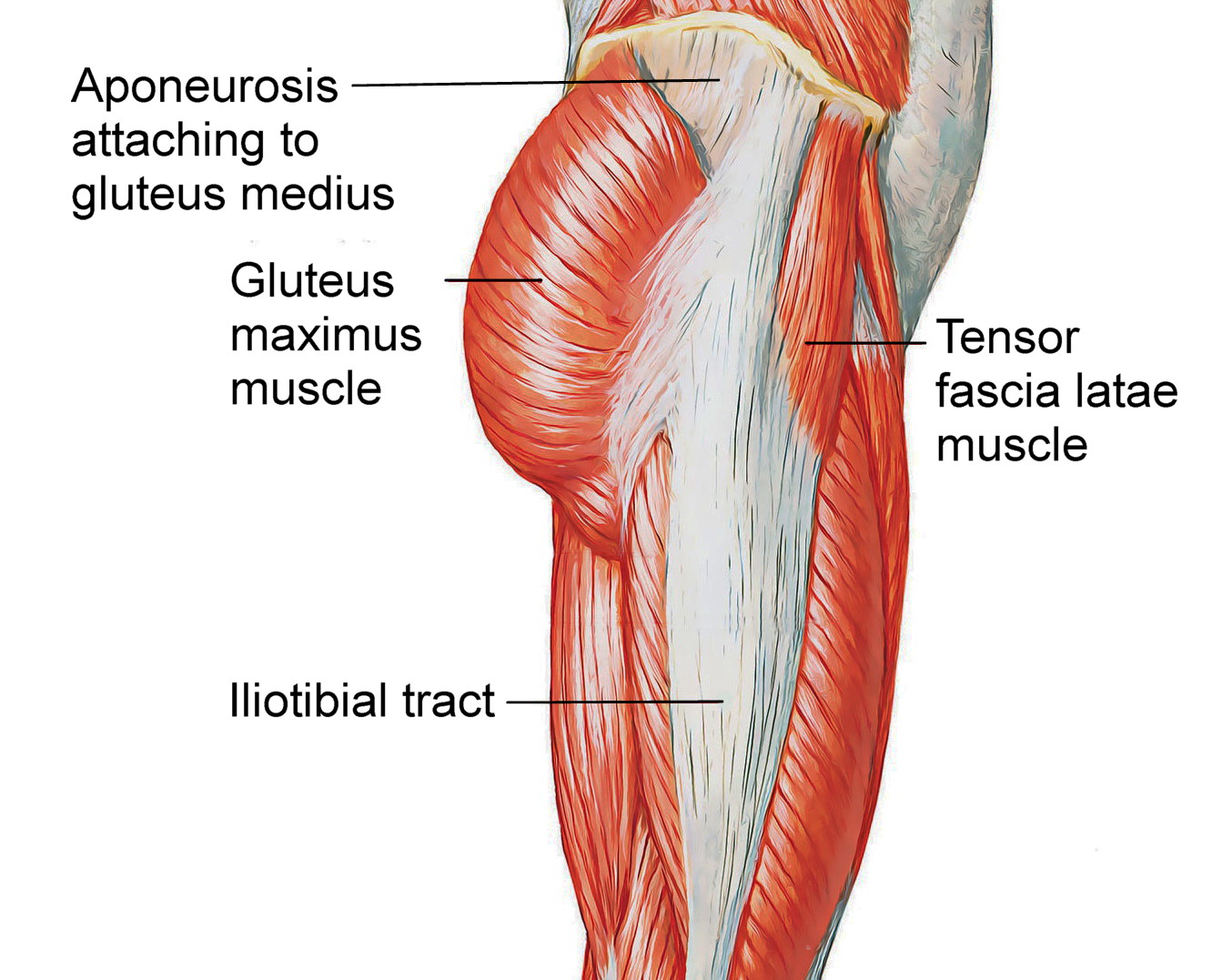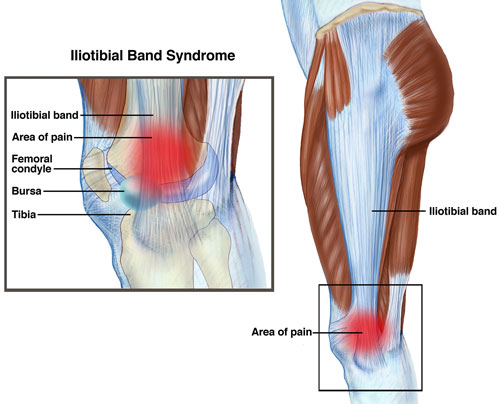Por qué el Estiramiento no Alivia el Síndrome de la Banda Iliotibial
El síndrome de la banda iliotibial es una afección inflamatoria dolorosa de la articulación de la rodilla que a menudo afecta a corredores, excursionistas y ciclistas. Por lo general, se recomienda el estiramiento para alargar la banda iliotibial y aliviar la afección, pero como aprenderá en esta publicación, el estiramiento estático tiene poco o ningún efecto duradero en la longitud de la banda iliotibial.
Read on to learn why pandiculation is the most effective way to release chronic tension in the iliotibial band and change habitual posture and movement patterns that may be contributing to the condition.
¿Qué es la banda iliotibial?
La banda iliotibial (banda IT, ITB) o tracto iliotibial es una banda larga y gruesa de tejido fibroso. La banda IT comienza en la cadera y desciende por la parte exterior del muslo, uniéndose debajo de la articulación de la rodilla en el borde externo de la tibia (espinilla).
La banda IT está compuesta principalmente de fibras de colágeno densamente empaquetadas dispuestas en líneas rectas, lo que le confiere una gran resistencia a la tracción. El tejido también contiene algunas proteínas elastina, que le confieren cierto grado de elasticidad. La banda IT proporciona una estabilización importante para la rodilla durante el movimiento.
As you can see in the diagram, the IT band is connected to three muscles: the tensor fascia latae, the gluteus maximus, and the gluteus medius (through an aponeurosis, a flat fibrotendinous tissue). Tightness in any of these three muscles will pull on the IT band, making it taut.

¿Qué es el síndrome de la banda iliotibial?
El síndrome de la banda iliotibial (síndrome de ITB, ITBS) se refiere al dolor inflamatorio que se siente en la parte lateral (exterior) de la rodilla como resultado del uso excesivo. El dolor puede comenzar como una sensación de pinchazo o escozor. Algunas personas también pueden sentir dolor arriba o debajo de la rodilla, o desde la parte externa del muslo hasta la cadera.
Typically, the IT band glides smoothly over the lateral femoral epicondyle when the knee is flexed and extended. But if the IT band is tight and then becomes overused, the friction created during movement of the knee joint can lead to painful inflammation of the IT band.
Algunas personas con síndrome de la banda iliotibial pueden sentir un chasquido o un estallido en la rodilla al flexionarla y extenderla. A medida que avanza el síndrome de la banda iliotibial, las personas pueden sentir un dolor extremo al caminar, subir y bajar escaleras y cada vez que el talón golpea el suelo.

¿Qué causa el síndrome de la banda iliotibial?
Several factors affect whether or not someone will get iliotibial band syndrome. The first is having a tight iliotibial band. As mentioned above, chronic tightness in any or all three of the muscles that attach to the IT band—the tensor fascia latae, the gluteus maximus, and the gluteus medius—will pull on the IT band, making it taut.
The second factor is overuse. When the IT band is pulled taut due to muscle tension and it is then overused, ITB syndrome can easily occur. The most common cause of overuse is athletic training that involves repeated flexing and extending of the knees, like running, hiking, cycling, and playing soccer.
The third factor in developing iliotibial band syndrome is having an imbalance in posture or movement. Functional leg length discrepancy, overpronation of the feet, and bowleggedness are all associated with increased risk of ITB syndrome. Likewise, running on a horizontally banked surface, like the shoulder of a road or an indoor track, stretches the IT band against the lateral femoral epicondyle of the downhill leg and can cause ITB syndrome.
Cómo salir del dolor: cómo aliviar el síndrome de la banda iliotibial
Si está tratando de curarse del síndrome de ITB, deberá abordar los tres factores que influyen en él.
First, you should reduce or take a break altogether from the activity that is overusing your knee joint in order to allow the inflammation to subside. While it can be difficult to take time off from an activity that you love, you must give your body a chance to heal—otherwise you will continue to make your pain worse, and potentially cause permanent damage to your knee joint.
A medida que reanude gradualmente la actividad física, le recomiendo encarecidamente el entrenamiento cruzado: hacer dos, tres o más tipos diferentes de entrenamientos que utilicen su cuerpo de diferentes maneras (como correr, nadar y hacer yoga). El entrenamiento cruzado es la mejor manera de lograr un alto nivel de condición física mientras se evitan lesiones por uso repetitivo.
Second, you must address the chronic tension in the muscles that attach to your IT band. This is why static stretching is often recommended to relieve ITB syndrome. Unfortunately, due to the stretch reflex (myotatic reflex), static stretching will have little to no effect on the level of tension in these muscles. If you’re not familiar with the stretch reflex, be sure to read What is the Stretch Reflex (Myotatic Reflex)?
In order to release the chronic tension in the tensor fascia latae, gluteus maximus, and gluteus medius, you must pandiculate them. Pandiculation contracts and releases muscles in a specific way so that accurate biofeedback is sent to the nervous system, allowing the resting level of tension in the muscles to be reset.
Pandiculation also addresses the third factor in ITB syndrome: imbalanced posture and movement patterns. Imbalanced use of the body is caused simply by muscle memory. As we repeat certain postures and movements over and over, our nervous system gradually makes the muscular contraction involved in these patterns automatic. This is why people who spend long hours at a computer develop rounded posture, and why weightlifters have tight lower backs; it’s all the result of muscle memory. If you’d like to learn more about this topic, check out El Secreto del Alivio del Dolor.
Uso de ejercicios de somática clínica para aliviar el síndrome de la banda iliotibial
La clinical somatic education es un método de educación neuromuscular desarrollado por Thomas Hanna. Hanna creó muchos ejercicios de cuidado personal que utilizan su técnica de pandiculación para liberar la tensión muscular crónica e involuntaria y reentrenar el sistema nervioso.
You can learn Clinical Somatics exercises in the online Level One & Two Courses. These two courses together include all 40 exercises that I teach, allowing you to thoroughly address the muscle tension and imbalances throughout your body.
The following exercises from the Level One & Two Courses are the most effective exercises for releasing the tight muscles that cause mechanical back pain.
If you want more guidance on how to improve your posture, please read Cómo volver a entrenar su propiocepción y postura.
Curso de Nivel Uno
Arch & Flatten: This exercise allows you to release and regain control of the lower back and abdominal muscles, improving the alignment of the pelvis and lower back.
Back Lift: This exercise is practiced lying on the stomach, allowing you to most effectively pandiculate the muscles on the back side of your body, from your shoulders to your lower back and gluteals.
Side Curl: This exercise is important for everyone to do, especially if you have IT band pain more on one side than the other. This exercise releases the obliques and quadratus lumborum, which can hike one hip up, causing functional leg length discrepancy.
One-Sided Arch & Curl and Diagonal Arch & Curl: These exercises release the lower back and abdominal muscles. They focus on one side of your body at a time, allowing you to address imbalances in your muscular patterns.
Iliopsoas Release: This is an important exercise for everyone to do regularly, especially if you have tension or pain in your lower body.
Hip Rotation: This exercise releases the internal and external hip rotators, which are nearly always tight in cases of IT band pain.
Hamstring Release: Tight hamstrings often go along IT band tension and pain, so this is an important exercise to do daily.
Curso de Nivel Dos
Quadriceps Releases: Many people with IT band syndrome have chronic tension in all of their leg muscles – often from intense athletic training – and it’s important to release tension throughout the legs in order to fully address the problem.
Gluteal Release: This exercise works directly with releasing the glutes, which are tight in IT band syndrome.
Iliotibial Band Release: While you may have to be patient to get to this exercise in the course, you may have already felt complete relief at this point by having addressed tension in the core of your body and other leg muscles.
Calf Release: Many people with IT band syndrome spend a lot of time on their feet, and likely have tension in their calf muscles.
Standing Hamstring Release: This exercise is an intense hamstring release, and should only be practiced after becoming comfortable with all of the previous exercises for the legs and lower back.
Ejercicio Propioceptivo 2
Lectura recomendada:
The Pain Relief Secret: How to Retrain Your Nervous System, Heal Your Body, and Overcome Chronic Pain by Sarah Warren, CSE
Somatics: Reawakening the Mind’s Control of Movement, Flexibility and Health by Thomas Hanna

